by Lisa Cooke | Apr 9, 2013 | 01 What's New, NARA, Records & databases, Research Skills
Beware: Personal Opinions are coming your way in this article!
In my book The Genealogist’s Google Toolbox I emphasize how to use Google to determine what is already available and free online before investing your limited time and money in offline family history searching. Smart genealogists allocate their resources wisely, getting the most bang for their buck. And collaboration between individual genealogists allows us to accomplish even more.
 It looks like the U.S. Federal Government could learn a thing or two from savvy genealogists. The Washington Times is reporting that Congress’s auditor has discovered that our tax payer money given to the federal government isn’t being spent very wisely. (Imagine that!) Agencies fail to collaborate and share information, creating redundancy and overspending.
It looks like the U.S. Federal Government could learn a thing or two from savvy genealogists. The Washington Times is reporting that Congress’s auditor has discovered that our tax payer money given to the federal government isn’t being spent very wisely. (Imagine that!) Agencies fail to collaborate and share information, creating redundancy and overspending.
One example from the article: the Commerce Department “has been charging other government agencies millions of dollars for reports that the other agencies could just as easily have gotten online, for free – often with a Google search.”
This news makes it even harder to swallow the news that the National Archives and Records Administration (NARA) is suffering reduced hours of service due to budgetary issues.
The Bottom Line:
Google Twice, Pay Once (and only if you have to!)
by Lisa Cooke | Oct 11, 2017 | 01 What's New, Archive Lady, Archives
New archival collections at your favorite repository may be the long-awaited key to solving your family history mysteries! But how can you keep up with what’s new at archives and libraries? Professional archivist Melissa Barker shares her favorite tips.
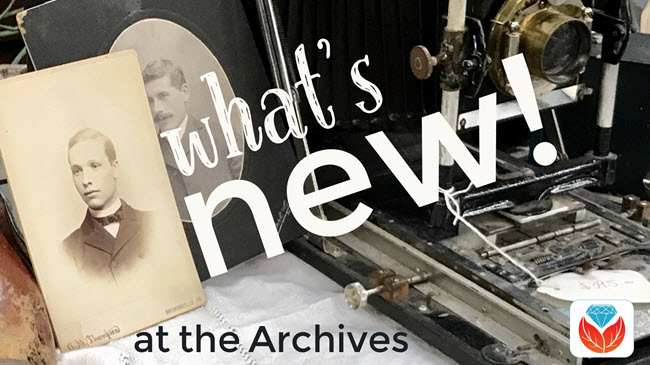
Not long ago, Lisa Louise Cooke read my article on what’s new at the Utah State Archives. She asked me how I keep up with new archival collections at my favorite repositories.
New Archival Collections May Be Just What We Need
Many of us can say that our ancestors were living in a certain area and their records should be located at certain local archives, libraries, or genealogical or historical societies. Maybe we have even done research there in the past, either by visiting the facility, contacting them by phone or email, or using their records online. Records, photographs, ephemera, and artifacts are constantly being discovered and made available in all of our wonderful archives. Many of these records may not make it to microfilm or online, but they are so rich with family information. (Don’t know where to look? Click here to learn how to find archives and libraries near your ancestor’s locale.)
But trying to keep up with all the new records that are being processed in archives, libraries, and genealogical societies can make your head spin! So how are genealogists supposed to stay current?
3 Ways to Keep Up with New Archival Collections
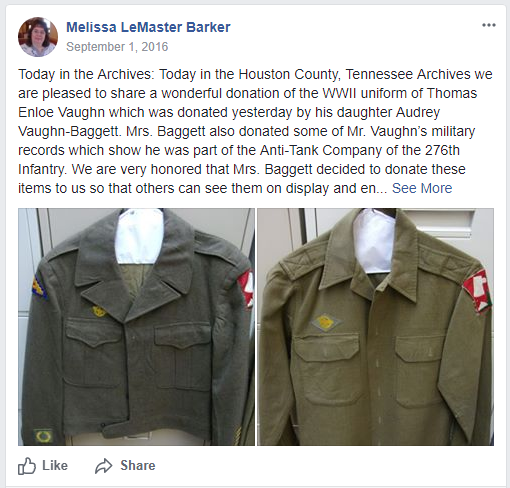 1. Check the archives website. See if they have announced new records collections that are available for research (many archives do). The archives may even have a blog or newsletter that you can subscribe to, which will give you the latest news right at your fingertips. Not only will the archives announce new records that are available but they will even let their patrons know what has been recently donated to the archives and which records are currently being processed.
1. Check the archives website. See if they have announced new records collections that are available for research (many archives do). The archives may even have a blog or newsletter that you can subscribe to, which will give you the latest news right at your fingertips. Not only will the archives announce new records that are available but they will even let their patrons know what has been recently donated to the archives and which records are currently being processed.
2. See if the archive has a social media presence. Archives like to post photos of new discoveries and records collections that are ready for the researcher. I know at the Houston County, TN. Archives I like to scan and post images of great documents or artifacts to Facebook, Twitter, Instagram, and Pinterest. (Like the post pictured here that I shared recently.)
LISA’S TIP: Remember to use Google search terms to find your favorite archive’s website and social media homes! A quick search such as National Archives Pinterest might be faster than trying to find it on the actual social media site. That search brings up tempting boards for National Archives in both the US and the UK:
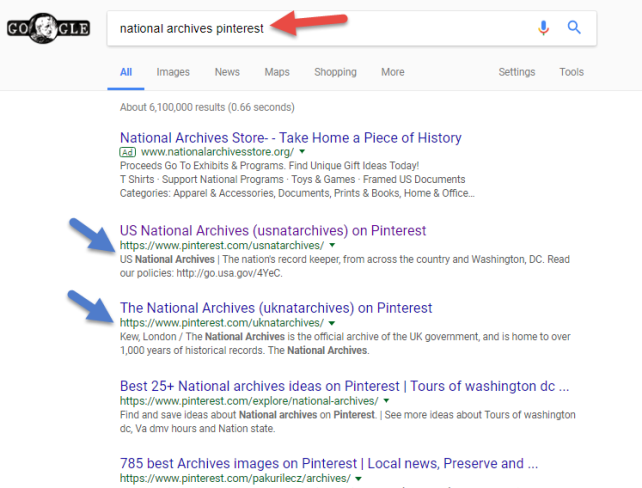
3. When visiting an archive, ask: “What’s new?” Talk to archivists about records collections that have recently been processed and made available for research. This is a great way to find more information and records about your ancestors. As an archivist who processes records on a daily basis that are not online or even microfilmed, I get excited about sharing what I find with the genealogy community.
Until next time, this is The Archive Lady, remember it’s not all online, so contact or visit an archive today!
Learn More about Using Archival Collections
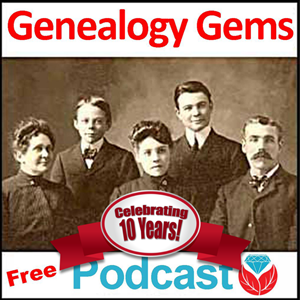 Listen to me on the free Genealogy Gems Podcast! This year the podcast is celebrating its 10th-year anniversary. Tune in to hear more inspiring stories and tips to help your family history research. Listen on your computer or on your mobile device through the Genealogy Gems app. Click here to learn more.
Listen to me on the free Genealogy Gems Podcast! This year the podcast is celebrating its 10th-year anniversary. Tune in to hear more inspiring stories and tips to help your family history research. Listen on your computer or on your mobile device through the Genealogy Gems app. Click here to learn more.
by Lisa Cooke | Jun 25, 2016 | 01 What's New, Evernote |
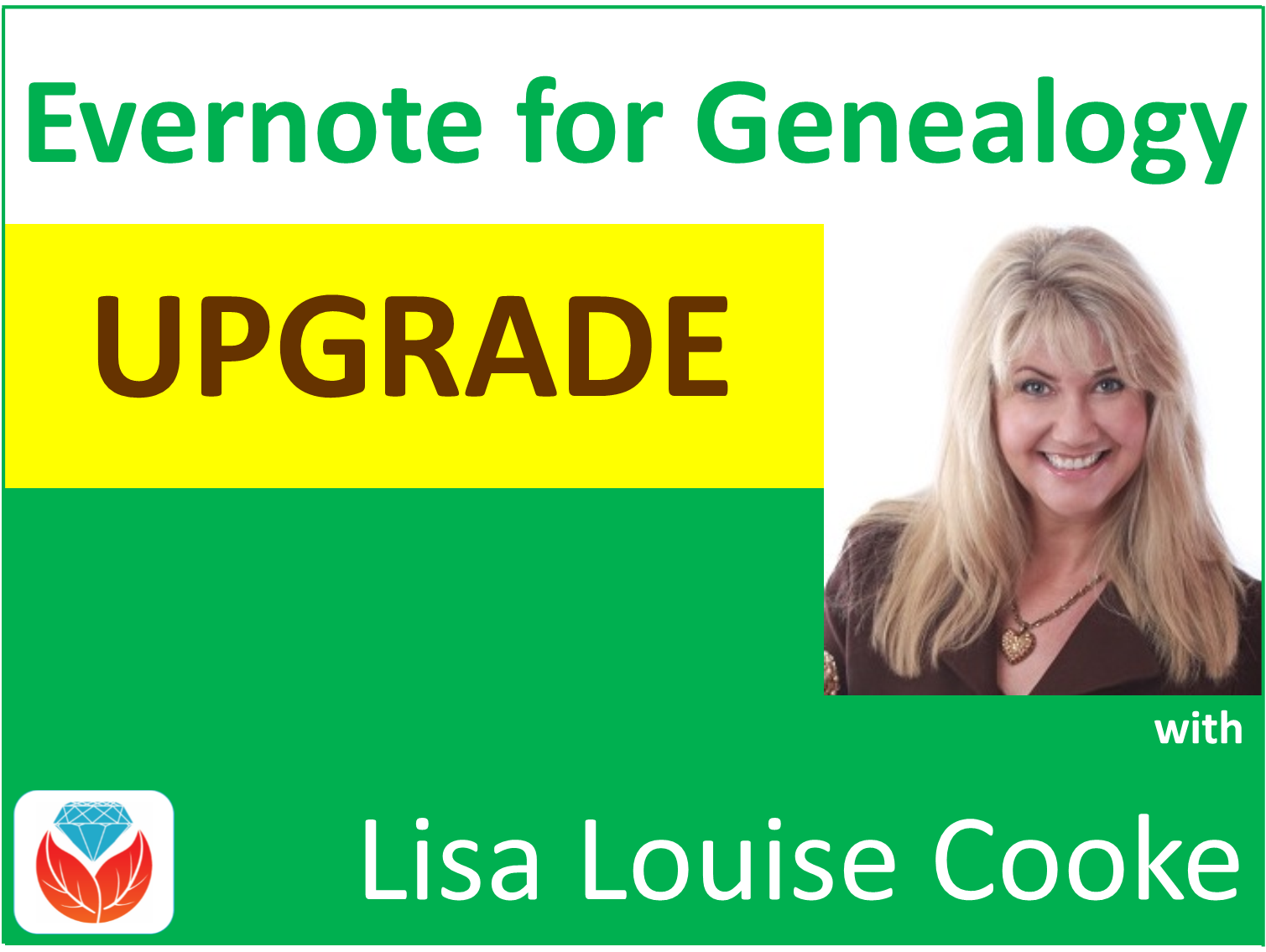
The Evernote for Windows upgrade has received a major face-lift. It is getting some great reviews online. Here’s what to love about it.
If you’re a Windows user and you’re still not using Evernote to organize your genealogy and the rest of your life, perhaps it’s time to take a look and see if it’s right for you and your research.
If you’re already a user, a new Evernote for Windows upgrade will make your experience all the better.
Evernote for Windows Upgrade New Look and Functionality
The Evernote blog explained that their goal “is to provide an experience that feels natural and familiar for Windows users. Our latest version is designed for all types of Evernote Windows users in mind, whether you have just a handful of notes or thousands of them.” They continue to say, “We began by paring down the left sidebar for a more streamlined workflow, so you can find and manage your content even faster.”
Here’s a run-down of the improvements they’re touting:
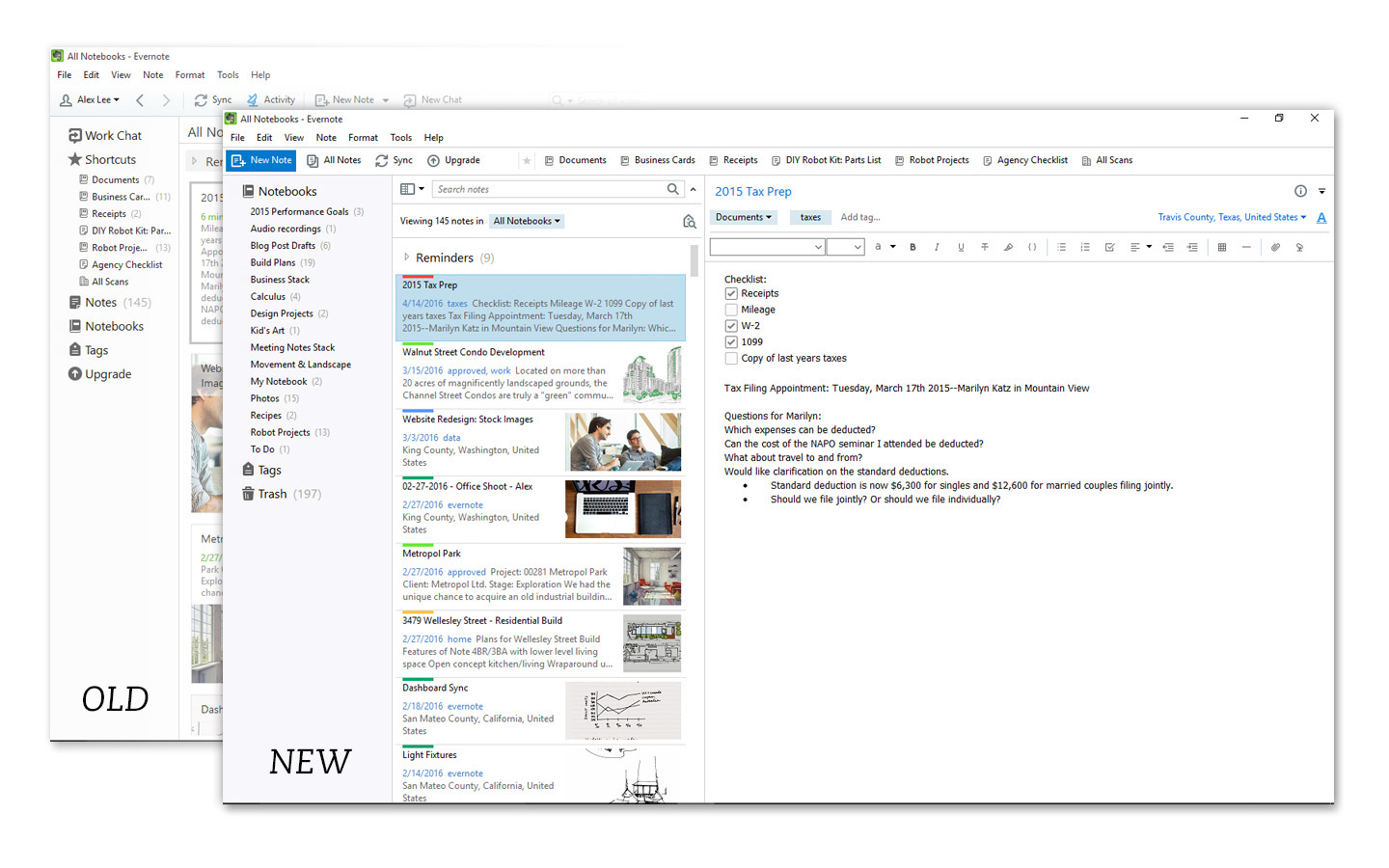
- A new higher-resolution display looks crisp and clean, even on high-resolution screens.
- The left sidebar is pared down for a more streamlined workflow. This makes it easier to find and manage content. For example, you can select Notebooks to pull up all notes in the Note list, and expand the Notebooks section to see all the notebook stacks and notebooks. You can drag and drop notebooks between stacks. The trash is now its own section.
- A new quick navigation feature lets you hover over the Notebooks section and jump quickly to a specific notebook or create a new one. This also works for tags.
- The search is smarter and more powerful, even for those with complex tags and tons of notes. It also feels more like web browser searching. You can widen or narrow your search to specific notebooks. The search system will rummage through your Evernote Trash now, too.
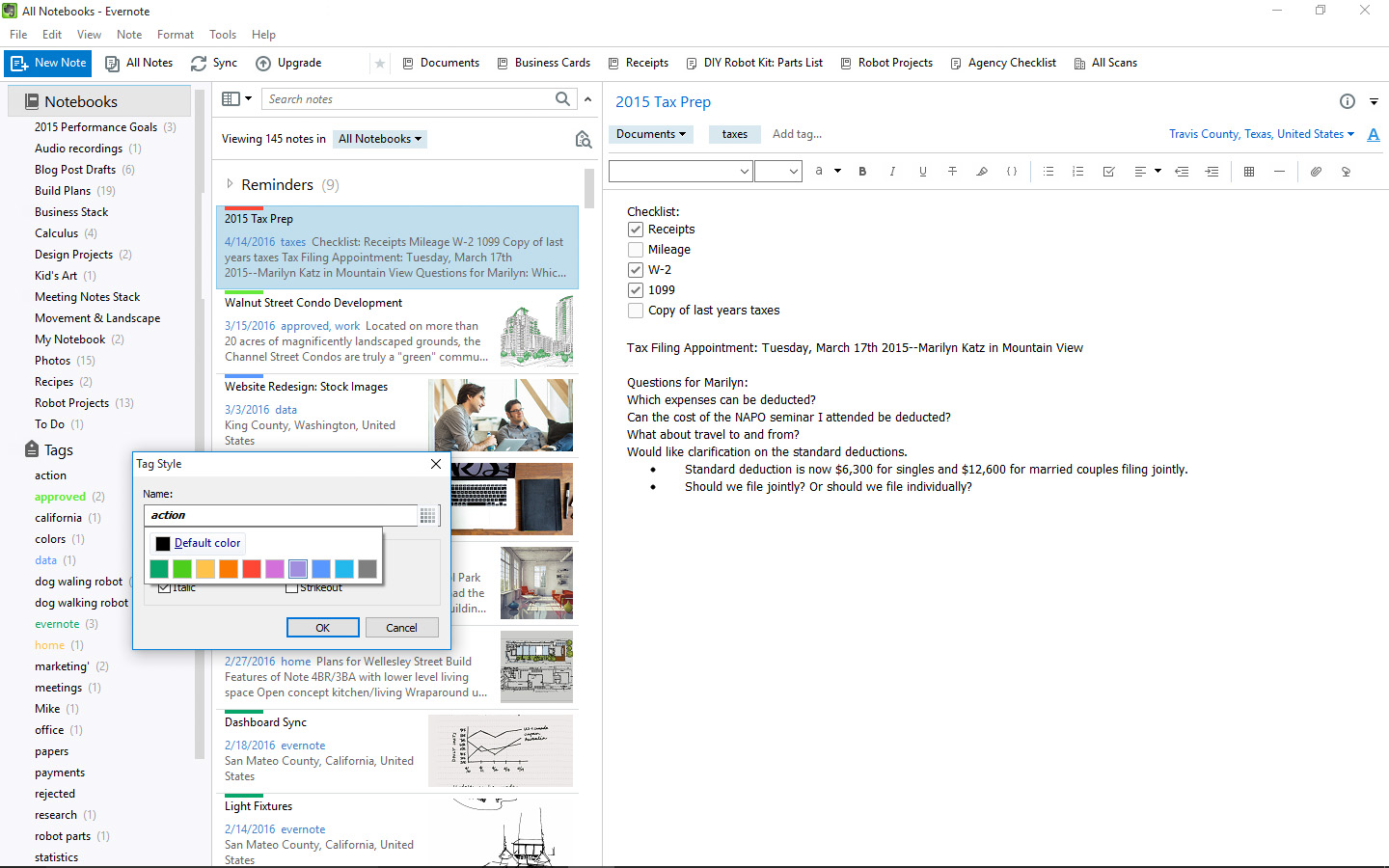
Image by Evernote.
- There’s a new color-coding system to let you mark important notes. So far, this is pretty popular with dedicated Evernote users.
- And finally, if you use Evernote Business, you’ll find a new separation between business and personal content.
It’s worth noting that the upgrade takes a while to complete and while it’s happening, you won’t be able to use Evernote. And at least for now, the saved searches of previous versions have disappeared. Evernote says that’s temporary.
What others are saying
TechTimes says the new Evernote for Windows has “a slew of improvements bound to enhance the overall experience.” Engadget.com calls the upgrade “a streamlined, cleaner approach with refinements addressing the sidebar’s design and functionality.”
How to get organized with Evernote!
Click here to learn about how to get started with Evernote, and more about using Evernote to organize your genealogy life.
What do you think about the new upgrade? Feel free to share your experience in the comments section below.
by Lisa Cooke | Sep 10, 2015 | 01 What's New, Ancestry, British, FamilySearch, Findmypast, images, Immigration, Records & databases, Travel, United States
 Have you ever thought to use passport applications for genealogy–to search for your immigrant or traveling ancestors?
Have you ever thought to use passport applications for genealogy–to search for your immigrant or traveling ancestors?
Passports were issued in the U.S. beginning in the late 1700s, but weren’t required except during times of war until 1941. These records can be an excellent place to learn an immigrant’s date of arrival, the arrival ship and date of naturalization (if naturalized).
Two Quick Tips for Researching U.S. Passports for Genealogy
- Passports expired every few years, so people reapplied. You may find multiple applications for those who traveled abroad more than once. Subsequent applications will refer back to a prior one.
- In earlier years, look for married women and minor children in group passports issued under the name of the head of household.
Where to Find Passport Applications

Resources
A Page of History: Passport Applications by Phil Golfarb
Genealogy Gems Premium Podcast Episode 124 interview with author Phil Goldfarb on the history of passport applications and celebrity passport stories. Available to Genealogy Gems Premium members.
Family History Made Easy podcast for free, step-by-step beginner and back-to-basics genealogy education
 Thanks for sharing this post with your genealogy buddies and on your local society social media channels.
Thanks for sharing this post with your genealogy buddies and on your local society social media channels.
by Lacey Cooke | Jun 16, 2019 | 01 What's New, Records & databases
Featured this week are new and updated records for South Africa. The all-free site FamilySearch has two new and one updated collection for South Africa including death and probate records and passenger lists. Ancestry.com also has an updated collection of church records going back to the 17th century. Also new at Ancestry.com are four genealogy records collections for Essex, England.

Featured: South Africa Genealogy Records
If you have ancestors that lived in South Africa, you may already be familiar with some of the challenges of researching them. And if you’re new to genealogy or to your ancestors that lived in South Africa, you might be in for a surprise when it comes to records: census records aren’t available! They are routinely destroyed after being abstracted and thus not available to the public.
So where’s the best place to start looking? Most genealogy experts will tell you to start with death notices. A death notice is different than a death certificate, in that it’s not an official document. Rather, it is a document provided by next of kin, friends, or associates of the deceased. Information provided may not be 100% accurate or reliable, but it can often provide really helpful details and a glimpse into the person’s life.
FamilySearch as a new collection of South Africa, Orange Free State, Probate Records from the Master of the Supreme Court, 1832-1989. There are over 300,000 records in this set, and the most useful records in the collection are the death notices, which give detailed information. The probate records usually have multiple pages and are included in a probate file, which is identified by a probate number.
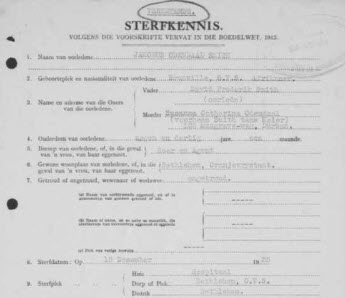
When a person died, the nearest relative or other connection should have completed a death notice and sent it to the Master of the High Court within 14 days of the death. These records might tell you the deceased’s name, birthdate and place, marriage status, parents’ names, the names of their children, information about property and wills left, and more.
There is an updated collection of actual death certificates at FamilySearch, which is the
Transvaal, Civil Death, 1869-1954 collection. “Death certificates are arranged chronologically and alphabetically by place and include full name, parent’s name if under the age of ten, mother’s residence, age, sex, birthplace, marital status, occupation, whether pensioner or pensioner’s dependent, place and date of death, residence, place of burial, cause and duration of death, and background of informant. For the years 1899-1902, records are arranged separately by internment camp and district where death occurred.”
If you’re an Ancestry.com subscriber, you can also check out the recently updated collection of
Dutch Reformed Church Registers, 1660-1970. This collection contains records from various locations which were part of historic Cape Colony, including Namibia, Cape of Good Hope province and Transvaal province. Record coverage will vary depending on location. It is also available at
FamilySearch.
Essex, England
Ancestry.com has four new collections of genealogy records for Essex, England. These BMD records date back as far as the 16th century and may hold important details about the lives of your ancestors living in Essex.
Church of England Births and Baptisms, 1813-1918: “Children were usually baptised within a few days or weeks of birth. The records generally include when the baptism took place and in what parish, child’s Christian name, parents’ given names and the family surname, residence, father’s occupation, and who performed the ceremony. Sometimes you’ll find additional details such as date of birth. Early records may contain less detail.”
Church of England Marriages, 1754-1935: “Couples were usually married in the bride’s parish. Marriage records typically include the bride and groom’s names, residence, date and location of the marriage, names of witnesses, condition (bachelor, spinster, widow, or widower) and the name of the officiant. Some records may also include the father’s name and occupation.”
Church of England Deaths and Burials, 1813-1994: “Burials took place within a few days of death. Records generally list the name of the deceased, residence, burial date, and age at death.”
Church of England Baptisms, Marriages and Burials, 1538-1812: “This collection contains images of Church of England parish registers of baptisms and burials during the years 1538–1812, and marriages during the years 1538-1754 from Essex, England.”
Get more new and updated records every week!
 Each week we round up the new and updated genealogy records collections for you in a helpful article so you can jump right into researching! Our free weekly email newsletter always has the latest records round up article, as well as other featured articles on genealogy methodology, inspiration, tips and tricks, and more. Plus the newsletter also lets you know where there is a new episode of The Genealogy Gems Podcast, new videos, and updates on news and events. And best of all it’s free! Sign up today to get our email newsletter once a week in your inbox.
Each week we round up the new and updated genealogy records collections for you in a helpful article so you can jump right into researching! Our free weekly email newsletter always has the latest records round up article, as well as other featured articles on genealogy methodology, inspiration, tips and tricks, and more. Plus the newsletter also lets you know where there is a new episode of The Genealogy Gems Podcast, new videos, and updates on news and events. And best of all it’s free! Sign up today to get our email newsletter once a week in your inbox.

About the Author: Lisa Louise Cooke is the producer and host of the Genealogy Gems Podcast, an online genealogy audio show and app. She is the author of the books The Genealogist’s Google Toolbox, Mobile Genealogy, How to Find Your Family History in Newspapers, and the Google Earth for Genealogy video series. She is an international keynote speaker and the Vice President of the Genealogical Speakers Guild.
Disclosure: This article contains affiliate links and Genealogy Gems will be compensated if you make a purchase after clicking on these links (at no additional cost to you). Thank you for supporting Genealogy Gems
 It looks like the U.S. Federal Government could learn a thing or two from savvy genealogists. The Washington Times is reporting that Congress’s auditor has discovered that our tax payer money given to the federal government isn’t being spent very wisely. (Imagine that!) Agencies fail to collaborate and share information, creating redundancy and overspending.
It looks like the U.S. Federal Government could learn a thing or two from savvy genealogists. The Washington Times is reporting that Congress’s auditor has discovered that our tax payer money given to the federal government isn’t being spent very wisely. (Imagine that!) Agencies fail to collaborate and share information, creating redundancy and overspending.

 1. Check the archives website. See if they have announced new records collections that are available for research (many archives do). The archives may even have a blog or newsletter that you can subscribe to, which will give you the latest news right at your fingertips. Not only will the archives announce new records that are available but they will even let their patrons know what has been recently donated to the archives and which records are currently being processed.
1. Check the archives website. See if they have announced new records collections that are available for research (many archives do). The archives may even have a blog or newsletter that you can subscribe to, which will give you the latest news right at your fingertips. Not only will the archives announce new records that are available but they will even let their patrons know what has been recently donated to the archives and which records are currently being processed.










